headlamp FIAT FULLBACK 2018 Owner handbook (in English)
[x] Cancel search | Manufacturer: FIAT, Model Year: 2018, Model line: FULLBACK, Model: FIAT FULLBACK 2018Pages: 316, PDF Size: 10.52 MB
Page 11 of 316
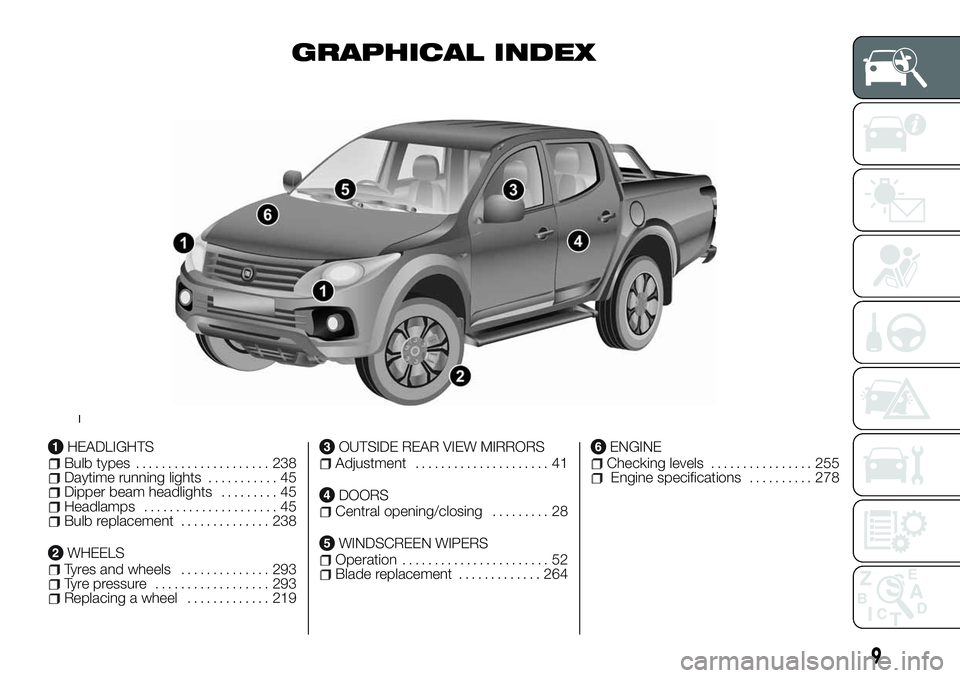
GRAPHICAL INDEX
HEADLIGHTSBulb types..................... 238Daytime running lights........... 45Dipper beam headlights......... 45Headlamps..................... 45Bulb replacement.............. 238
WHEELSTyres and wheels.............. 293Tyre pressure.................. 293Replacing a wheel............. 219
OUTSIDE REAR VIEW MIRRORSAdjustment..................... 41
DOORSCentral opening/closing......... 28
WINDSCREEN WIPERSOperation....................... 52Blade replacement............. 264
ENGINEChecking levels................ 255Engine specifications.......... 278
1
9
Page 43 of 316
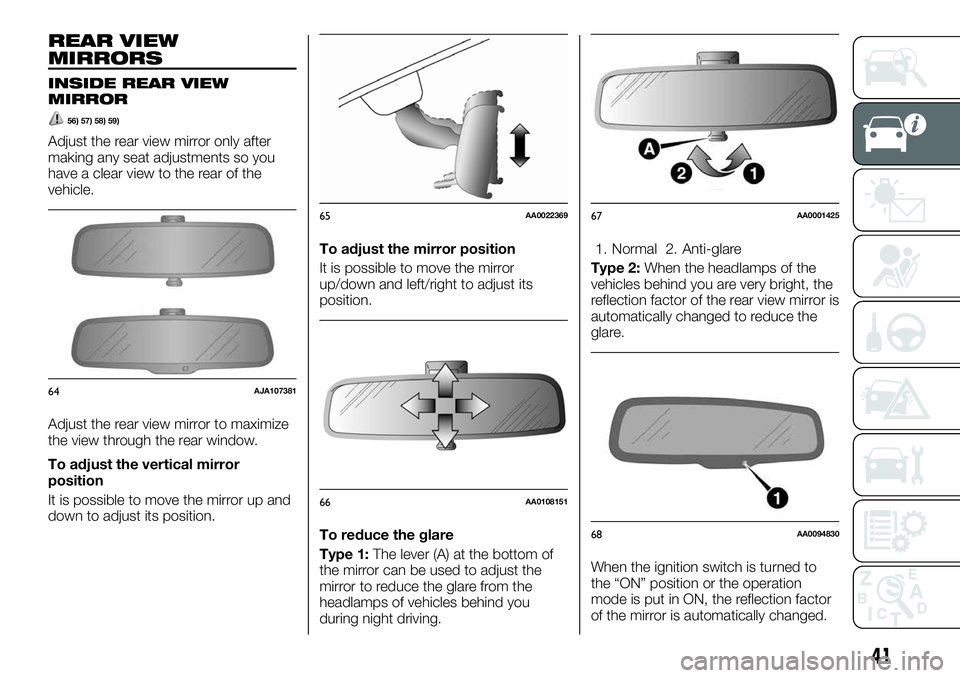
REAR VIEW
MIRRORS
INSIDE REAR VIEW
MIRROR
56) 57) 58) 59)
Adjust the rear view mirror only after
making any seat adjustments so you
have a clear view to the rear of the
vehicle.
Adjust the rear view mirror to maximize
the view through the rear window.
To adjust the vertical mirror
position
It is possible to move the mirror up and
down to adjust its position.To adjust the mirror position
It is possible to move the mirror
up/down and left/right to adjust its
position.
To reduce the glare
Type 1:The lever (A) at the bottom of
the mirror can be used to adjust the
mirror to reduce the glare from the
headlamps of vehicles behind you
during night driving.1. Normal 2. Anti-glare
Type 2:When the headlamps of the
vehicles behind you are very bright, the
reflection factor of the rear view mirror is
automatically changed to reduce the
glare.
When the ignition switch is turned to
the “ON” position or the operation
mode is put in ON, the reflection factor
of the mirror is automatically changed.
64AJA107381
65AA0022369
66AA0108151
67AA0001425
68AA0094830
41
Page 47 of 316
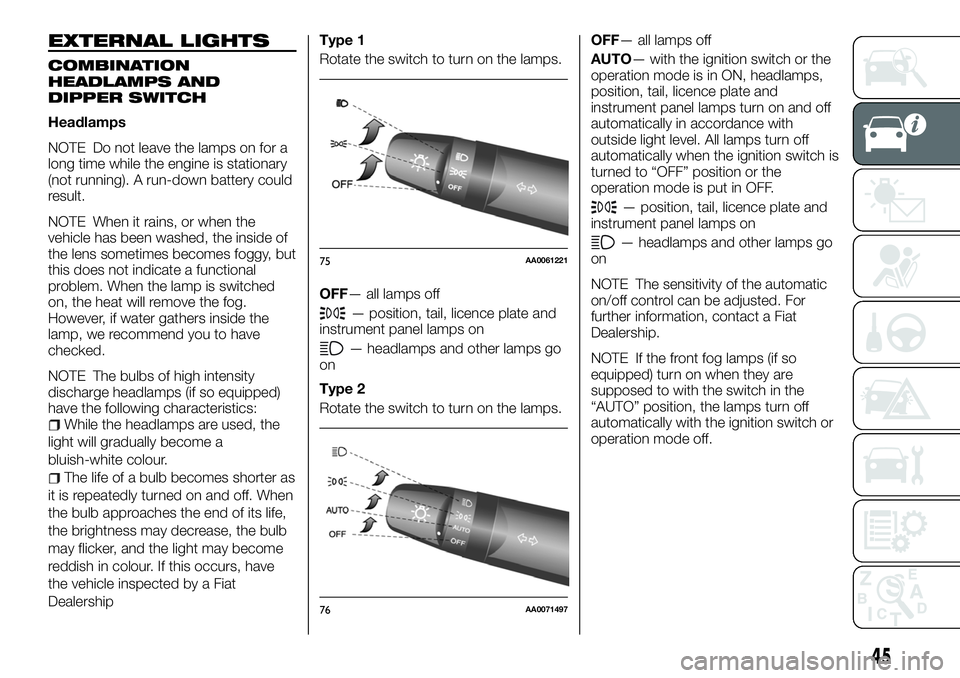
EXTERNAL LIGHTS
COMBINATION
HEADLAMPS AND
DIPPER SWITCH
Headlamps
NOTE Do not leave the lamps on for a
long time while the engine is stationary
(not running). A run-down battery could
result.
NOTE When it rains, or when the
vehicle has been washed, the inside of
the lens sometimes becomes foggy, but
this does not indicate a functional
problem. When the lamp is switched
on, the heat will remove the fog.
However, if water gathers inside the
lamp, we recommend you to have
checked.
NOTE The bulbs of high intensity
discharge headlamps (if so equipped)
have the following characteristics:
While the headlamps are used, the
light will gradually become a
bluish-white colour.
The life of a bulb becomes shorter as
it is repeatedly turned on and off. When
the bulb approaches the end of its life,
the brightness may decrease, the bulb
may flicker, and the light may become
reddish in colour. If this occurs, have
the vehicle inspected by a Fiat
Dealership
Type 1
Rotate the switch to turn on the lamps.
OFF— all lamps off
— position, tail, licence plate and
instrument panel lamps on
— headlamps and other lamps go
on
Type 2
Rotate the switch to turn on the lamps.OFF— all lamps off
AUTO— with the ignition switch or the
operation mode is in ON, headlamps,
position, tail, licence plate and
instrument panel lamps turn on and off
automatically in accordance with
outside light level. All lamps turn off
automatically when the ignition switch is
turned to “OFF” position or the
operation mode is put in OFF.
— position, tail, licence plate and
instrument panel lamps on
— headlamps and other lamps go
on
NOTE The sensitivity of the automatic
on/off control can be adjusted. For
further information, contact a Fiat
Dealership.
NOTE If the front fog lamps (if so
equipped) turn on when they are
supposed to with the switch in the
“AUTO” position, the lamps turn off
automatically with the ignition switch or
operation mode off.
75AA0061221
76AA0071497
45
Page 48 of 316
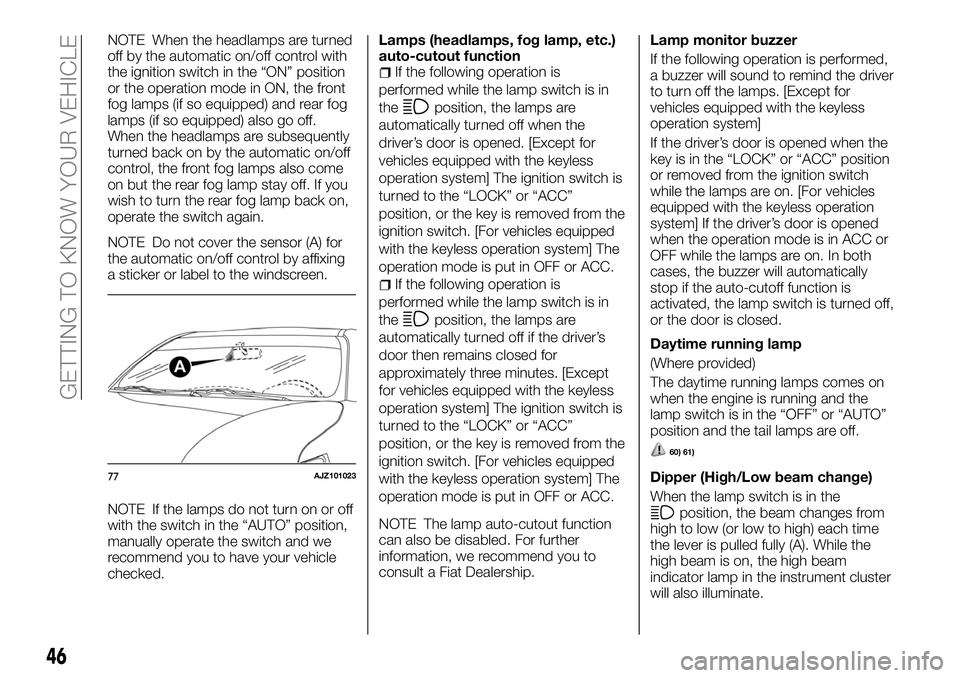
NOTE When the headlamps are turned
off by the automatic on/off control with
the ignition switch in the “ON” position
or the operation mode in ON, the front
fog lamps (if so equipped) and rear fog
lamps (if so equipped) also go off.
When the headlamps are subsequently
turned back on by the automatic on/off
control, the front fog lamps also come
on but the rear fog lamp stay off. If you
wish to turn the rear fog lamp back on,
operate the switch again.
NOTE Do not cover the sensor (A) for
the automatic on/off control by affixing
a sticker or label to the windscreen.
NOTE If the lamps do not turn on or off
with the switch in the “AUTO” position,
manually operate the switch and we
recommend you to have your vehicle
checked.Lamps (headlamps, fog lamp, etc.)
auto-cutout function
If the following operation is
performed while the lamp switch is in
the
position, the lamps are
automatically turned off when the
driver’s door is opened. [Except for
vehicles equipped with the keyless
operation system] The ignition switch is
turned to the “LOCK” or “ACC”
position, or the key is removed from the
ignition switch. [For vehicles equipped
with the keyless operation system] The
operation mode is put in OFF or ACC.
If the following operation is
performed while the lamp switch is in
the
position, the lamps are
automatically turned off if the driver’s
door then remains closed for
approximately three minutes. [Except
for vehicles equipped with the keyless
operation system] The ignition switch is
turned to the “LOCK” or “ACC”
position, or the key is removed from the
ignition switch. [For vehicles equipped
with the keyless operation system] The
operation mode is put in OFF or ACC.
NOTE The lamp auto-cutout function
can also be disabled. For further
information, we recommend you to
consult a Fiat Dealership.Lamp monitor buzzer
If the following operation is performed,
a buzzer will sound to remind the driver
to turn off the lamps. [Except for
vehicles equipped with the keyless
operation system]
If the driver’s door is opened when the
key is in the “LOCK” or “ACC” position
or removed from the ignition switch
while the lamps are on. [For vehicles
equipped with the keyless operation
system] If the driver’s door is opened
when the operation mode is in ACC or
OFF while the lamps are on. In both
cases, the buzzer will automatically
stop if the auto-cutoff function is
activated, the lamp switch is turned off,
or the door is closed.
Daytime running lamp
(Where provided)
The daytime running lamps comes on
when the engine is running and the
lamp switch is in the “OFF” or “AUTO”
position and the tail lamps are off.
60) 61)
Dipper (High/Low beam change)
When the lamp switch is in the
position, the beam changes from
high to low (or low to high) each time
the lever is pulled fully (A). While the
high beam is on, the high beam
indicator lamp in the instrument cluster
will also illuminate.
77AJZ101023
46
GETTING TO KNOW YOUR VEHICLE
Page 49 of 316
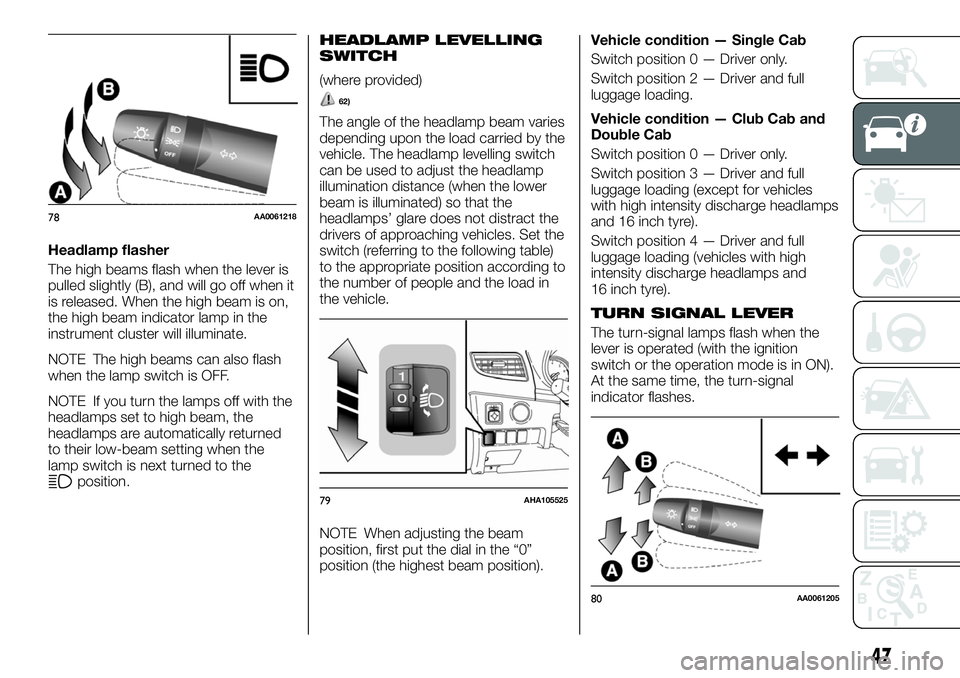
Headlamp flasher
The high beams flash when the lever is
pulled slightly (B), and will go off when it
is released. When the high beam is on,
the high beam indicator lamp in the
instrument cluster will illuminate.
NOTE The high beams can also flash
when the lamp switch is OFF.
NOTE If you turn the lamps off with the
headlamps set to high beam, the
headlamps are automatically returned
to their low-beam setting when the
lamp switch is next turned to the
position.
HEADLAMP LEVELLING
SWITCH
(where provided)
62)
The angle of the headlamp beam varies
depending upon the load carried by the
vehicle. The headlamp levelling switch
can be used to adjust the headlamp
illumination distance (when the lower
beam is illuminated) so that the
headlamps’ glare does not distract the
drivers of approaching vehicles. Set the
switch (referring to the following table)
to the appropriate position according to
the number of people and the load in
the vehicle.
NOTE When adjusting the beam
position, first put the dial in the “0”
position (the highest beam position).Vehicle condition — Single Cab
Switch position 0 — Driver only.
Switch position 2 — Driver and full
luggage loading.
Vehicle condition — Club Cab and
Double Cab
Switch position 0 — Driver only.
Switch position 3 — Driver and full
luggage loading (except for vehicles
with high intensity discharge headlamps
and 16 inch tyre).
Switch position 4 — Driver and full
luggage loading (vehicles with high
intensity discharge headlamps and
16 inch tyre).
TURN SIGNAL LEVER
The turn-signal lamps flash when the
lever is operated (with the ignition
switch or the operation mode is in ON).
At the same time, the turn-signal
indicator flashes.
78AA0061218
79AHA105525
80AA0061205
47
Page 50 of 316
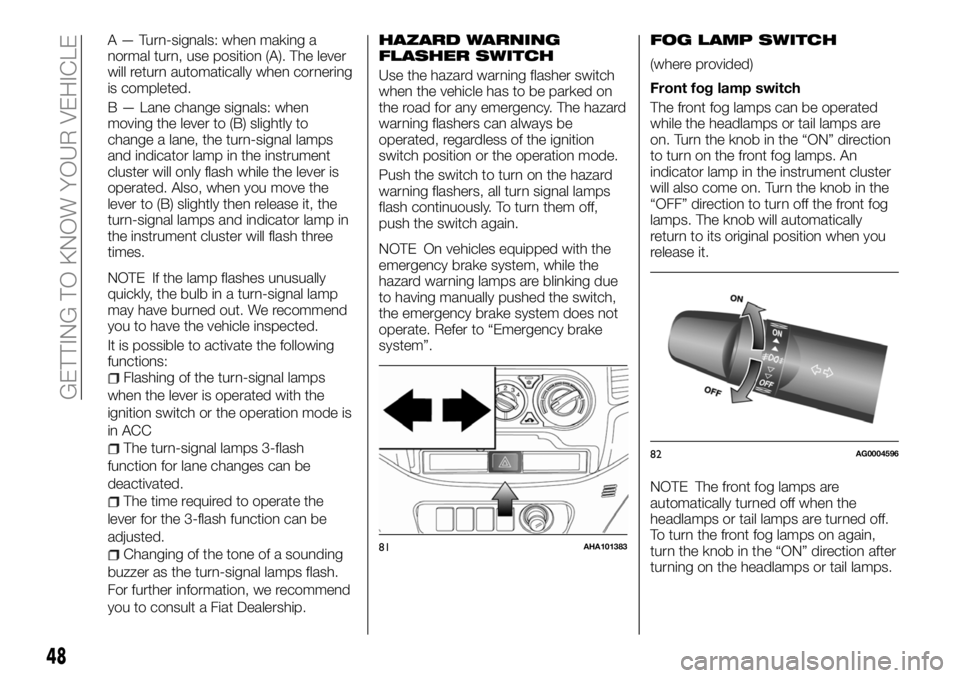
A — Turn-signals: when making a
normal turn, use position (A). The lever
will return automatically when cornering
is completed.
B — Lane change signals: when
moving the lever to (B) slightly to
change a lane, the turn-signal lamps
and indicator lamp in the instrument
cluster will only flash while the lever is
operated. Also, when you move the
lever to (B) slightly then release it, the
turn-signal lamps and indicator lamp in
the instrument cluster will flash three
times.
NOTE If the lamp flashes unusually
quickly, the bulb in a turn-signal lamp
may have burned out. We recommend
you to have the vehicle inspected.
It is possible to activate the following
functions:
Flashing of the turn-signal lamps
when the lever is operated with the
ignition switch or the operation mode is
in ACC
The turn-signal lamps 3-flash
function for lane changes can be
deactivated.
The time required to operate the
lever for the 3-flash function can be
adjusted.
Changing of the tone of a sounding
buzzer as the turn-signal lamps flash.
For further information, we recommend
you to consult a Fiat Dealership.
HAZARD WARNING
FLASHER SWITCH
Use the hazard warning flasher switch
when the vehicle has to be parked on
the road for any emergency. The hazard
warning flashers can always be
operated, regardless of the ignition
switch position or the operation mode.
Push the switch to turn on the hazard
warning flashers, all turn signal lamps
flash continuously. To turn them off,
push the switch again.
NOTE On vehicles equipped with the
emergency brake system, while the
hazard warning lamps are blinking due
to having manually pushed the switch,
the emergency brake system does not
operate. Refer to “Emergency brake
system”.
FOG LAMP SWITCH
(where provided)
Front fog lamp switch
The front fog lamps can be operated
while the headlamps or tail lamps are
on. Turn the knob in the “ON” direction
to turn on the front fog lamps. An
indicator lamp in the instrument cluster
will also come on. Turn the knob in the
“OFF” direction to turn off the front fog
lamps. The knob will automatically
return to its original position when you
release it.
NOTE The front fog lamps are
automatically turned off when the
headlamps or tail lamps are turned off.
To turn the front fog lamps on again,
turn the knob in the “ON” direction after
turning on the headlamps or tail lamps.
81AHA101383
82AG0004596
48
GETTING TO KNOW YOUR VEHICLE
Page 51 of 316
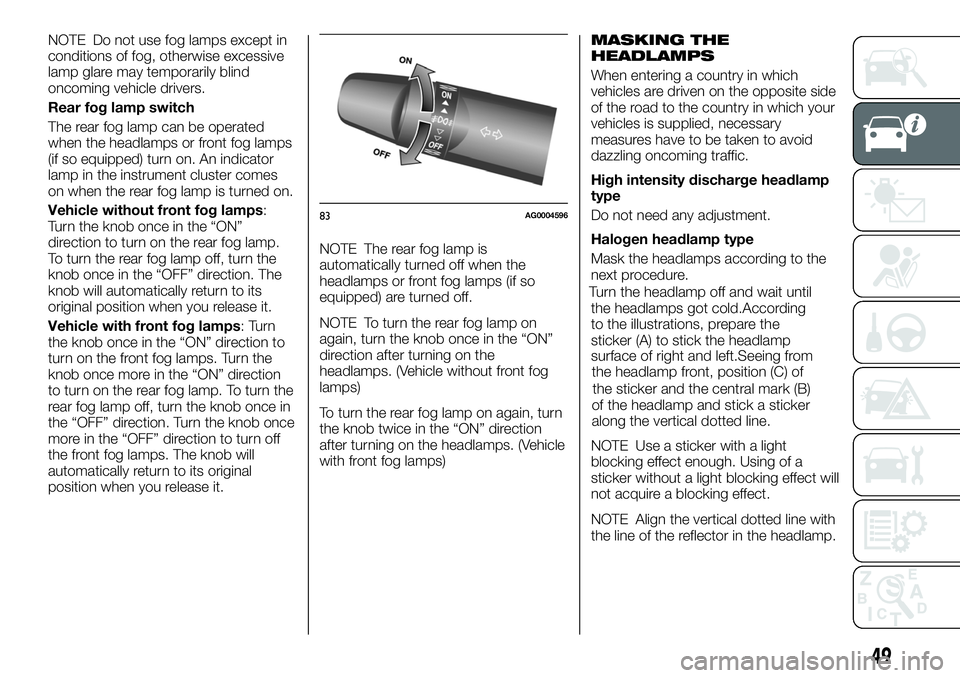
NOTE Do not use fog lamps except in
conditions of fog, otherwise excessive
lamp glare may temporarily blind
oncoming vehicle drivers.
Rear fog lamp switch
The rear fog lamp can be operated
when the headlamps or front fog lamps
(if so equipped) turn on. An indicator
lamp in the instrument cluster comes
on when the rear fog lamp is turned on.
Vehicle without front fog lamps:
Turn the knob once in the “ON”
direction to turn on the rear fog lamp.
To turn the rear fog lamp off, turn the
knob once in the “OFF” direction. The
knob will automatically return to its
original position when you release it.
Vehicle with front fog lamps: Turn
the knob once in the “ON” direction to
turn on the front fog lamps. Turn the
knob once more in the “ON” direction
to turn on the rear fog lamp. To turn the
rear fog lamp off, turn the knob once in
the “OFF” direction. Turn the knob once
more in the “OFF” direction to turn off
the front fog lamps. The knob will
automatically return to its original
position when you release it.NOTE The rear fog lamp is
automatically turned off when the
headlamps or front fog lamps (if so
equipped) are turned off.
NOTE To turn the rear fog lamp on
again, turn the knob once in the “ON”
direction after turning on the
headlamps. (Vehicle without front fog
lamps)
To turn the rear fog lamp on again, turn
the knob twice in the “ON” direction
after turning on the headlamps. (Vehicle
with front fog lamps)MASKING THE
HEADLAMPS
When entering a country in which
vehicles are driven on the opposite side
of the road to the country in which your
vehicles is supplied, necessary
measures have to be taken to avoid
dazzling oncoming traffic.
High intensity discharge headlamp
type
Do not need any adjustment.
Halogen headlamp type
Mask the headlamps according to the
next procedure.
Turn the headlamp off and wait until
the headlamps got cold.According
to the illustrations, prepare the
sticker (A) to stick the headlamp
surface of right and left.Seeing from
the headlamp front, position (C) of
the sticker and the central mark (B)
of the headlamp and stick a sticker
along the vertical dotted line.
NOTE Use a sticker with a light
blocking effect enough. Using of a
sticker without a light blocking effect will
not acquire a blocking effect.
NOTE Align the vertical dotted line with
the line of the reflector in the headlamp.
83AG0004596
49
Page 57 of 316
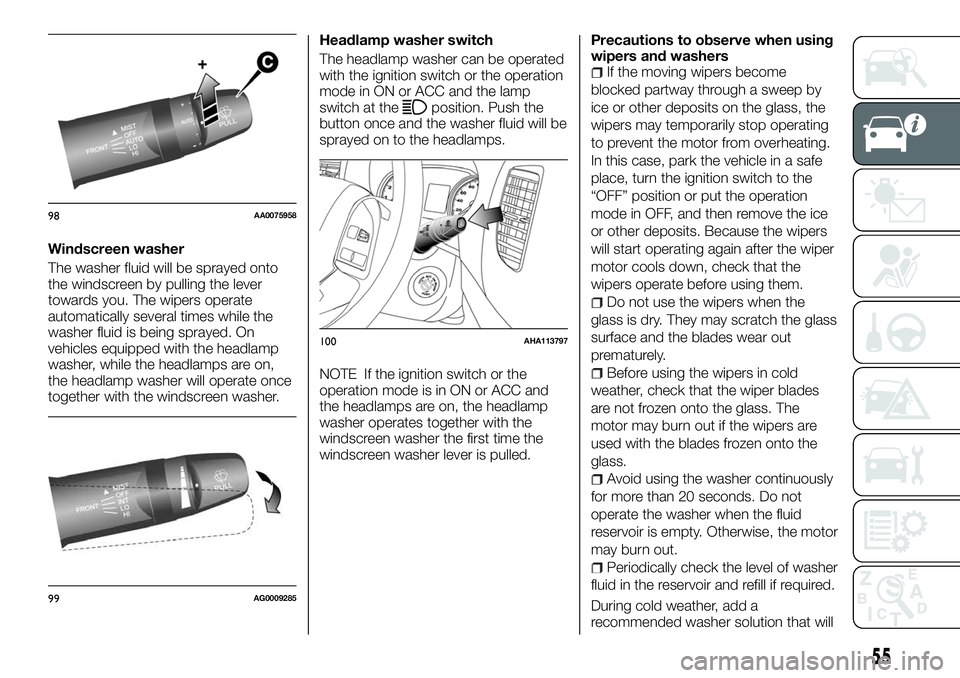
Windscreen washer
The washer fluid will be sprayed onto
the windscreen by pulling the lever
towards you. The wipers operate
automatically several times while the
washer fluid is being sprayed. On
vehicles equipped with the headlamp
washer, while the headlamps are on,
the headlamp washer will operate once
together with the windscreen washer.Headlamp washer switch
The headlamp washer can be operated
with the ignition switch or the operation
mode in ON or ACC and the lamp
switch at the
position. Push the
button once and the washer fluid will be
sprayed on to the headlamps.
NOTE If the ignition switch or the
operation mode is in ON or ACC and
the headlamps are on, the headlamp
washer operates together with the
windscreen washer the first time the
windscreen washer lever is pulled.Precautions to observe when using
wipers and washers
If the moving wipers become
blocked partway through a sweep by
ice or other deposits on the glass, the
wipers may temporarily stop operating
to prevent the motor from overheating.
In this case, park the vehicle in a safe
place, turn the ignition switch to the
“OFF” position or put the operation
mode in OFF, and then remove the ice
or other deposits. Because the wipers
will start operating again after the wiper
motor cools down, check that the
wipers operate before using them.
Do not use the wipers when the
glass is dry. They may scratch the glass
surface and the blades wear out
prematurely.
Before using the wipers in cold
weather, check that the wiper blades
are not frozen onto the glass. The
motor may burn out if the wipers are
used with the blades frozen onto the
glass.
Avoid using the washer continuously
for more than 20 seconds. Do not
operate the washer when the fluid
reservoir is empty. Otherwise, the motor
may burn out.
Periodically check the level of washer
fluid in the reservoir and refill if required.
During cold weather, add a
recommended washer solution that will
98AA0075958
99AG0009285
100AHA113797
55
Page 85 of 316
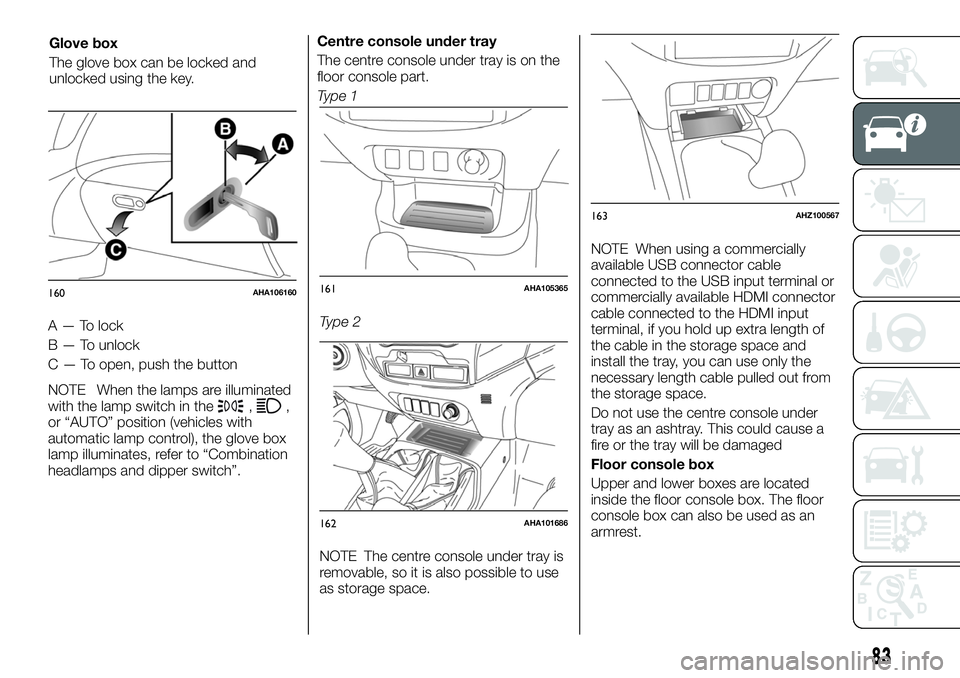
A — To lock
B — To unlock
C — To open, push the button
NOTE When the lamps are illuminated
with the lamp switch in the
,,
or “AUTO” position (vehicles with
automatic lamp control), the glove box
lamp illuminates, refer to “Combination
headlamps and dipper switch”.Centre console under tray
The centre console under tray is on the
floor console part.
Type 1
Type 2
NOTE The centre console under tray is
removable, so it is also possible to use
as storage space.NOTE When using a commercially
available USB connector cable
connected to the USB input terminal or
commercially available HDMI connector
cable connected to the HDMI input
terminal, if you hold up extra length of
the cable in the storage space and
install the tray, you can use only the
necessary length cable pulled out from
the storage space.
Do not use the centre console under
tray as an ashtray. This could cause a
fire or the tray will be damaged
Floor console box
Upper and lower boxes are located
inside the floor console box. The floor
console box can also be used as an
armrest.
160AHA106160161AHA105365
162AHA101686
163AHZ100567
83
Glove box
The glove box can be locked and
unlocked using the key.
Page 185 of 316
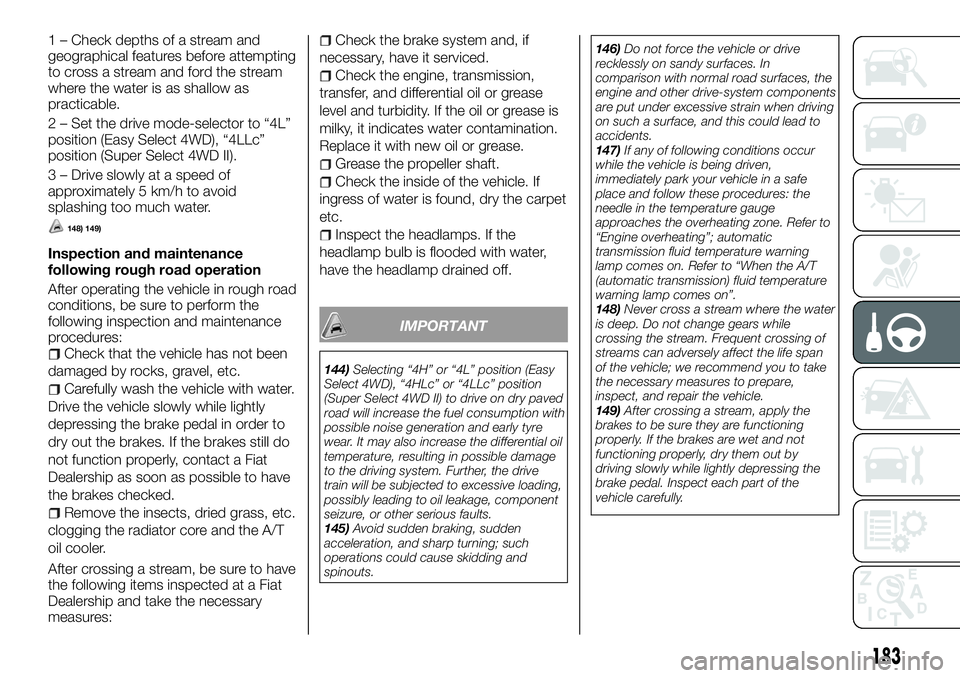
1 – Check depths of a stream and
geographical features before attempting
to cross a stream and ford the stream
where the water is as shallow as
practicable.
2 – Set the drive mode-selector to “4L”
position (Easy Select 4WD), “4LLc”
position (Super Select 4WD II).
3 – Drive slowly at a speed of
approximately 5 km/h to avoid
splashing too much water.
148) 149)
Inspection and maintenance
following rough road operation
After operating the vehicle in rough road
conditions, be sure to perform the
following inspection and maintenance
procedures:
Check that the vehicle has not been
damaged by rocks, gravel, etc.
Carefully wash the vehicle with water.
Drive the vehicle slowly while lightly
depressing the brake pedal in order to
dry out the brakes. If the brakes still do
not function properly, contact a Fiat
Dealership as soon as possible to have
the brakes checked.
Remove the insects, dried grass, etc.
clogging the radiator core and the A/T
oil cooler.
After crossing a stream, be sure to have
the following items inspected at a Fiat
Dealership and take the necessary
measures:
Check the brake system and, if
necessary, have it serviced.
Check the engine, transmission,
transfer, and differential oil or grease
level and turbidity. If the oil or grease is
milky, it indicates water contamination.
Replace it with new oil or grease.
Grease the propeller shaft.
Check the inside of the vehicle. If
ingress of water is found, dry the carpet
etc.
Inspect the headlamps. If the
headlamp bulb is flooded with water,
have the headlamp drained off.
IMPORTANT
144)Selecting “4H” or “4L” position (Easy
Select 4WD), “4HLc” or “4LLc” position
(Super Select 4WD II) to drive on dry paved
road will increase the fuel consumption with
possible noise generation and early tyre
wear. It may also increase the differential oil
temperature, resulting in possible damage
to the driving system. Further, the drive
train will be subjected to excessive loading,
possibly leading to oil leakage, component
seizure, or other serious faults.
145)Avoid sudden braking, sudden
acceleration, and sharp turning; such
operations could cause skidding and
spinouts.146)Do not force the vehicle or drive
recklessly on sandy surfaces. In
comparison with normal road surfaces, the
engine and other drive-system components
are put under excessive strain when driving
on such a surface, and this could lead to
accidents.
147)If any of following conditions occur
while the vehicle is being driven,
immediately park your vehicle in a safe
place and follow these procedures: the
needle in the temperature gauge
approaches the overheating zone. Refer to
“Engine overheating”; automatic
transmission fluid temperature warning
lamp comes on. Refer to “When the A/T
(automatic transmission) fluid temperature
warning lamp comes on”.
148)Never cross a stream where the water
is deep. Do not change gears while
crossing the stream. Frequent crossing of
streams can adversely affect the life span
of the vehicle; we recommend you to take
the necessary measures to prepare,
inspect, and repair the vehicle.
149)After crossing a stream, apply the
brakes to be sure they are functioning
properly. If the brakes are wet and not
functioning properly, dry them out by
driving slowly while lightly depressing the
brake pedal. Inspect each part of the
vehicle carefully.
183